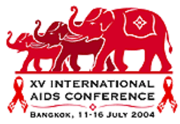 |
 |
 |
| |
Lopinavir/ritonavir- versus efavirenz-based therapy as the two first-line HAART regimens for naive HIV-infected subjects
|
| |
| |
|
|
| |
| |
 |
|
| |
| |
R Manfredi, L Calza, F Chiodo
Infectious Diseases, University of Bologna, Bologna, Italy
The 2003 guidelines for anti-HIV therapy consider lopinavir/ritonavir (L)- or efavirenz (E)-based HAART as 1st-line choice for naïve patients (p).
The efficacy-tolerability of Lopinavir/r (Kaletra)- vs Efavirenz- based HAART was assessed in 74 naïve patients since 2002: 39 consecutive patients treated with Lopinavir/r plus 2 nucleoside analogues (NA) were compared with 35 patients who received Efavirenz plus 2 NAs.
RESULTS
The 2 groups were comparable at baseline as to epidemiologic issues, as well as mean viremia (4.5±1.3,vs 4.3±1.7 Log HIV-RNA copies/mL, for L and E), but more p with prior-concurrent AIDS (p<.03), and a lower mean CD4 count (p <.003) were found among L-treated p.
Early (1st month) interruptions due to poor tolerability proved similar: 6 p in the L group vs 5 among E-treated p, although untoward events involved the GI tract for L and the CNS for E (p<.001).
During the 11-24-month follow-up, laboratory testing showed a comparable virologic response (as to time-rate of viral decay and suppression), in presence of only 1 case of virologic failure in the E group.
Notwithstanding the lower initial CD4 count, L-treated p achieved a more rapid and elevated immune recovery (p<.02).
The overall need of regimen switch due to toxicity, poor adherence, or failure, was comparable in the 2 groups, but mid-term toxicity was significantly different: L-treated p experienced dyslipidemia in >40% of cases, vs <10% in the E group (p<.001).
The authors concluded- Our experience on 74 antiretroviral-naïve patients treated with L- or E-based HAART, showed a similar virologic response, but and a more potent and rapid immunologic recovery was seen in the L group (despite a deeper immunodeficiency), while E-treated p experienced more rare adverse events, and benefited from a low pill burden.
The selection of L- vs E-based regimens has to consider the initial immunologic-disease status. Further data are warranted on long-term outcome, viral resistance, and tolerability, as well as targeted pharmacoeconomic evaluation of these two 1-st line antiretroviral regimens.
|
| |
|
 |
 |
|
|